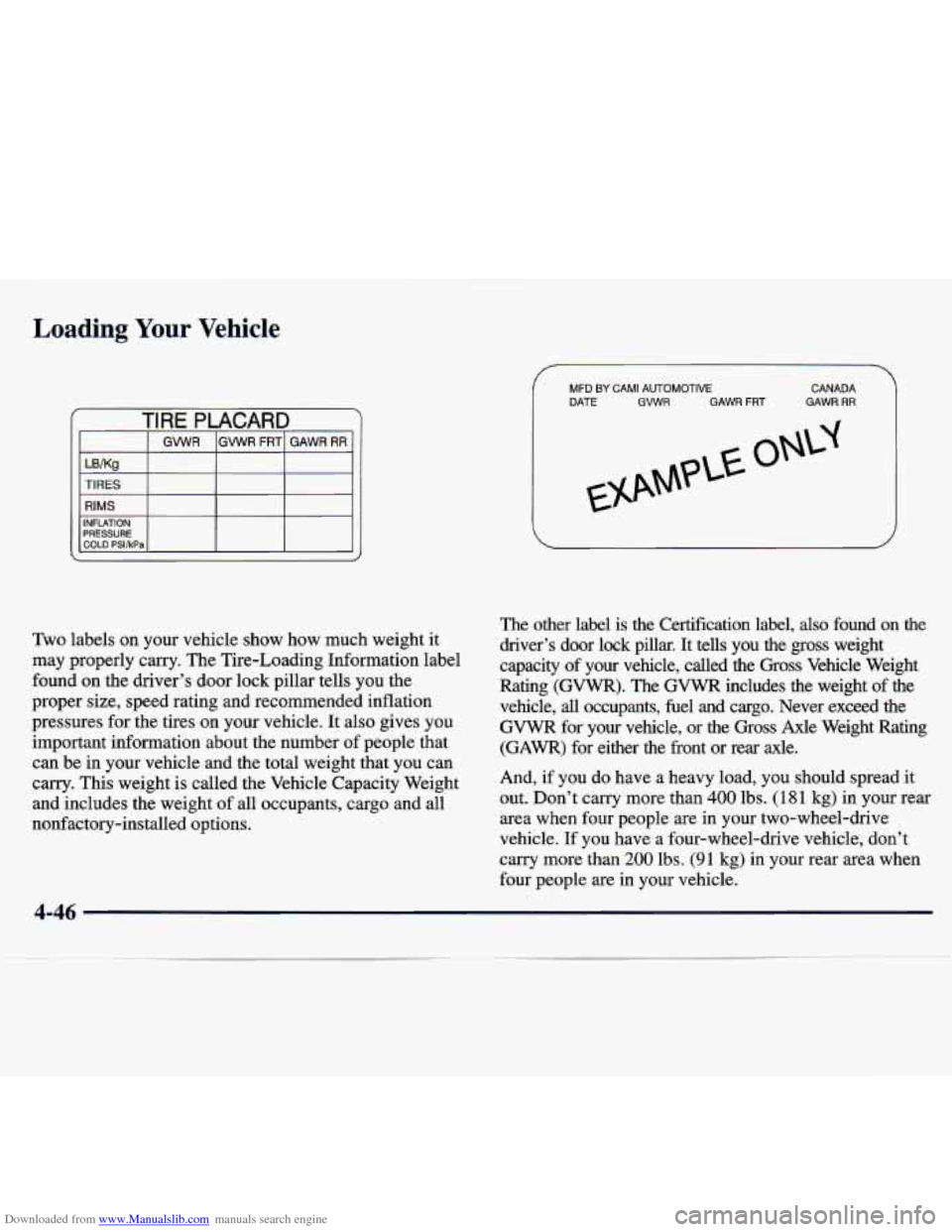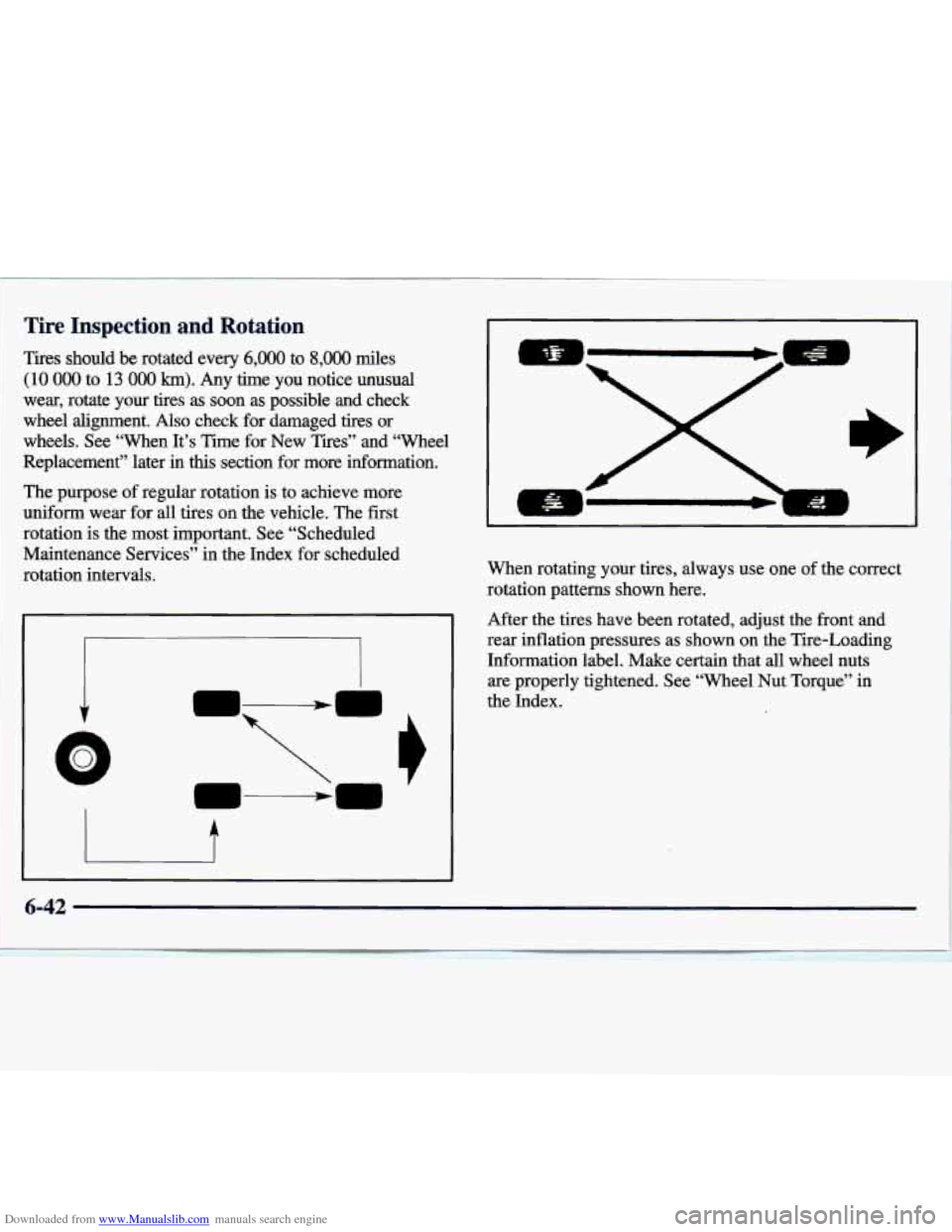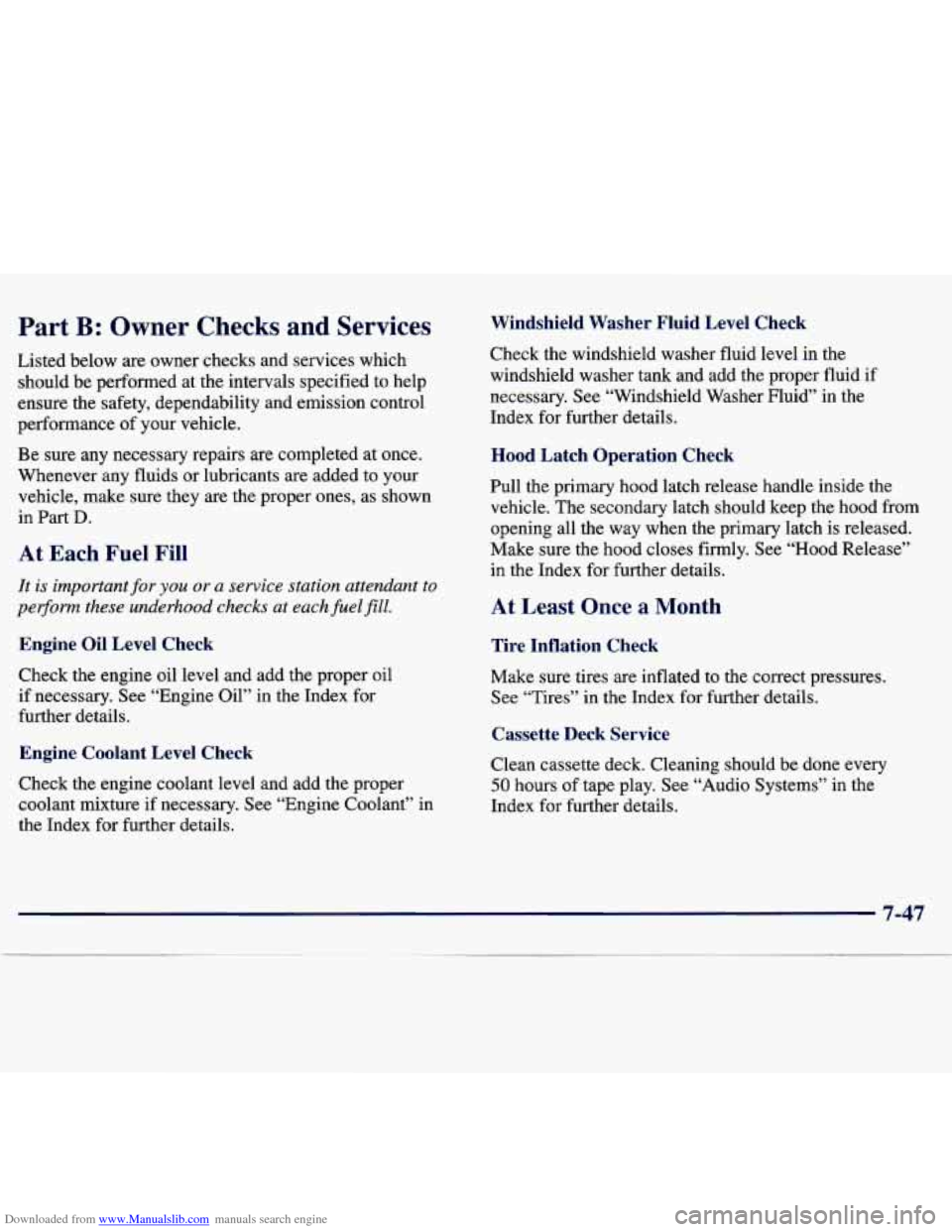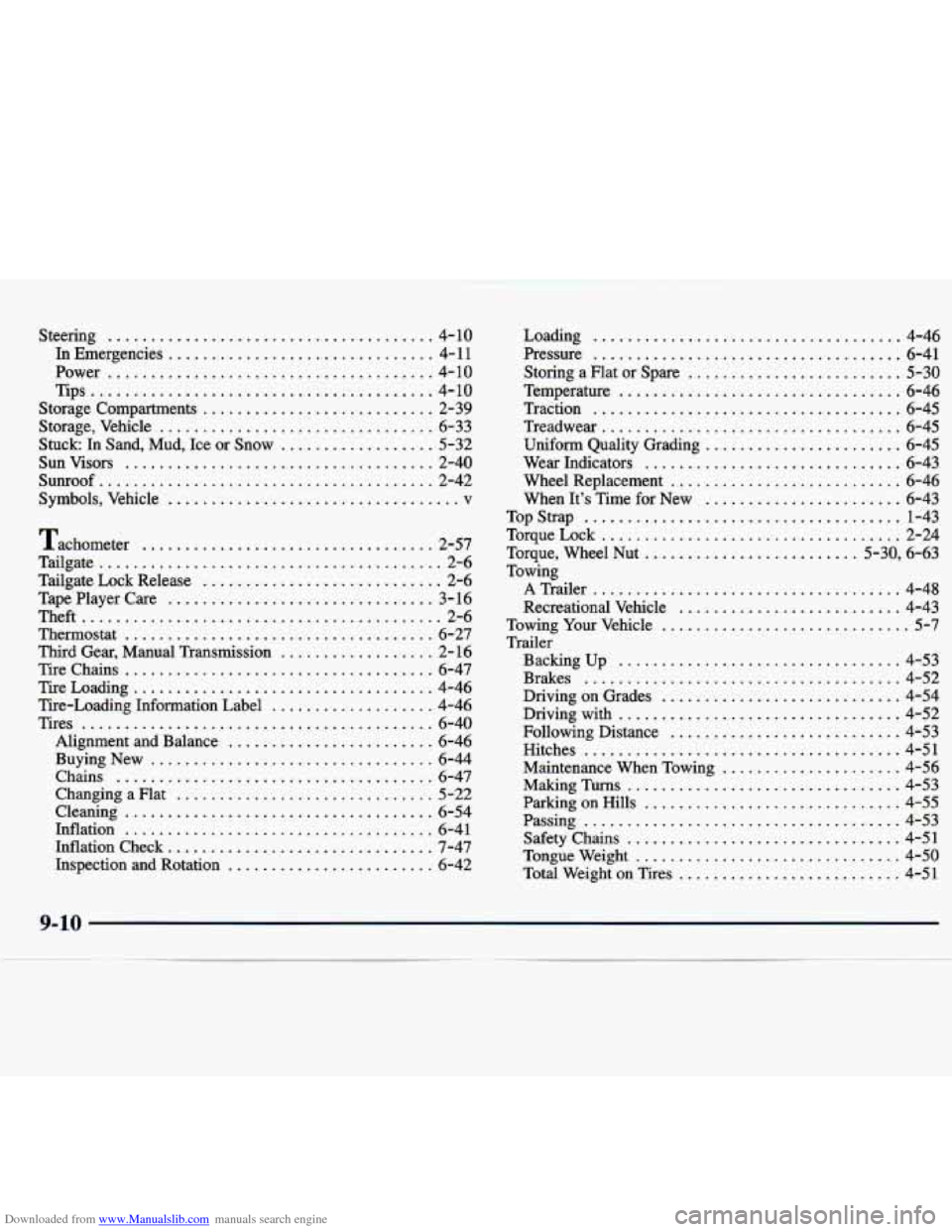inflation pressure CHEVROLET TRACKER 1998 1.G Owners Manual
[x] Cancel search | Manufacturer: CHEVROLET, Model Year: 1998, Model line: TRACKER, Model: CHEVROLET TRACKER 1998 1.GPages: 386, PDF Size: 21.17 MB
Page 191 of 386

Downloaded from www.Manualslib.com manuals search engine Loading Your Vehicle
TIRES
RIMS
MFD BY CAM1 AUTOMOTIVE
I DATE CANADA
GVWR GAWR FRT GAWR RR
Two labels on your vehicle show how much weight it
may properly carry. The Tire-Loading Information label
found on the driver's door lock pillar tells you the
proper size, speed rating and recommended inflation
pressures for the tires on your vehicle. It also gives you
important information about the number of people that
can be in your vehicle and the total weight that you can carry. This weight is called the Vehicle Capacity Weight
and includes the weight
of all occupants, cargo and all
nonfactory-installed options. The other label is the Certification label,
also found on the
driver's door lock pillar. It tells you the
gross weight
capacity of your vehicle, called the
Gross Vehicle Weight
Rating (GVWR). The GVWR includes the weight of the vehicle, all occupants,
fuel and cargo. Never exceed the
GVWR for your vehicle, or the Gross Axle Weight Rating
(GAWR) for either the front or rear axle.
And, if
you do have a heavy load, you should spread it
out. Don't carry more than
400 lbs. (1 8 1 kg) in your rear
area when four people are in your two-wheel-drive
vehicle.
If you have a four-wheel-drive vehicle, don't
carry more than
200 lbs. (9 1 kg) in your rear area when
four people are in your vehicle.
Page 278 of 386

Downloaded from www.Manualslib.com manuals search engine Inflation -- Tire Pressure
The Tire-Loading Information label, which is on the
driver’s door lock pillar, shows the correct inflation
pressures for your tires when they’re cold. “Cold”
means your vehicle has been sitting for at least three
hours or driven no more than
1 mile ( 1.6 km).
NOTICE:
Don’t let anyone tell you that underinflation or
overinflation
is all right. It’s not. If your tires
don’t have enough
air (underinflation), you can
get the following:
Too much flexing
Too much heat
Tire overloading
Bad wear
Bad handling
0 Bad fuel economy.
NOTICE: (Continued) NOTICE: (Continued)
If your tires have too much air
(overinflation),
you can get the following:
Unusual wear
Bad handling
0 Rough ride
Needless damage from road hazards.
When to Check Check your tires once
a month or more. Also, check
the tire pressure
of the spare tire.
How to Check
Use
a good quality pocket-type gage to check tire
pressure.
You can’t tell if your tires are properly inflated
simply by looking at them. Radial tires may look
properly inflated even when they’re underinflated.
Be sure to put the valve caps back on the valve stems. They help prevent leaks by keeping out dirt
and moisture.
Page 279 of 386

Downloaded from www.Manualslib.com manuals search engine ~~
~~~ ~ ~ ~~ ~~ ~~ -. .~~~
Tire Inspection and Rotation
Tires should be rotated every 6,000 to 8,000 miles
(10 000 to 13 000 km). Any time you notice unusual
wear, rotate your tires as soon as possible and check
wheel alignment.
Also check for damaged tires or
wheels. See “When It’s Time for New Tires” and “Whe\
el
Replacement” later in this section for more information.
The purpose
of regular rotation is to achieve more
uniform wear for all tires on the vehicle. The first
rotation is the most important. See “Scheduled
Maintenance Services” in the Index for scheduled
rotation intervals.
I
1
J.
4
When rotating your tires, always use one of the correct
rotation patterns shown here.
After the tires have been rotated, adjust the front and
rear inflation pressures as shown on the Tire-Loading
Information label. Make certain that
all wheel nuts
are properly tightened. See “Wheel Nut Torque” in
the Index.
! 6-42
Page 350 of 386

Downloaded from www.Manualslib.com manuals search engine Part B: Owner Checks and Services
Listed below are owner checks and services which should be performed at the intervals specified to help
ensure the safety, dependability and emission control
performance of your vehicle.
Be sure any necessary repairs are completed at once.
Whenever any fluids or lubricants are added to your
vehicle, make sure they are the proper ones, as shown
in
Part D.
At Each Fuel Fill
It is important for you or a service station attendant to
per3corm these underhood checks at eachfuelfill.
Engine Oil Level Check
Check the engine oil level and add the proper oil
if necessary. See “Engine Oil” in
the Index for
further details.
Engine Coolant Level Check
Check the engine coolant level and add the proper
coolant mixture if necessary. See “Engine Coolant” in
the Index for further details.
Windshield Washer Fluid Level Check
Check the windshield washer fluid level in the
windshield washer tank and add the proper fluid
if
necessary. See “Windshield Washer Fluid” in the
Index for further details.
Hood Latch Operation Check
Pull the primary hood latch release handle inside the
vehicle. The secondary latch should keep the hood from
opening all the way when the primary latch is released.
Make sure the hood closes firmly. See “Hood Release”
in the Index for further details.
At Least Once a Month
Tire Inflation Check
Make sure tires are inflated to the correct pressures.
See “Tires” in the Index for further details.
Cassette Deck Service
Clean cassette deck. Cleaning should be done every
50 hours of tape play. See “Audio Systems” in the
Index for further details.
7-47
Page 383 of 386

Downloaded from www.Manualslib.com manuals search engine Steering ...................................... 4-10
In Emergencies ............................... 4- 11
Power
...................................... 4-10
Tips
........................................ 4-10
Storage Compartments
........................... 2-39
Storage. Vehicle
................................ 6-33
Stuck:
In Sand. Mud. Ice or Snow .................. 5-32
Sun Visors
.................................... 2-40
Symbols. Vehicle
.................................. v
Sunroof ....................................... 2-42
Tachometer
.................................. 2-57
Tailgate
........................................ 2-6
Tailgate Lock Release
............................ 2-6
Tape Player Care
............................... 3-16
Theft
.......................................... 2-6
Thermostat
.................................... 6-27
Third Gear. Manual Transmission
.................. 2- 16
Tire Chains
.................................... 6-47
TireLoading
................................... 4-46
Tire-Loading Information Label
................... 4-46
Tires
......................................... 6-40
Alignment and Balance
........................ 6-46
Buying New
................................. 6-44
Chains
..................................... 6-47
Changing a Flat .............................. 5-22
Inflation
.................................... 6-41
Inflation Check
............................... 7-47
Inspection and Rotation
........................ 6-42
Cleaning
.................................... 6-54 Loading
....................................
Pressure ....................................
Storing a Flat or Spare .........................
Temperature .................................
Traction ....................................
Treadwe ar ...................................
Uniform Quality Grading .......................
Wear Indicators ..............................
Wheel Replacement ...........................
When It’s Time for New .......................
TopStrap .....................................
Torque Lock ...................................
Torque, Wheel Nut ......................... 5-30,
Towing ATrailer
....................................
Recreational Vehicle ..........................
Towing Your Vehicle ............................
Trailer Backing
Up .................................
Brakes .....................................
Driving on Grades ............................
Drivingwi th .................................
Following Distance ...........................
Hitches .....................................
Maintenance When Towing .....................
MakingTurns ................................
Parking on Hills ..............................
Passing .....................................
SafetyChains ................................
Tongueweight ...............................
Total Weight on Tires ..........................
4-46
6-41
5-30
6-46
6-45
6-45
6-45
6-43
6-46
6-43 1-43
2-24 6-63
4-48
4-43
.5-7
4-53
4-52
4-54
4-52
4-53
4-51
4-56
4-53
4-55
4-53
4-51
4-50
4-51